The NVIDIA GeForce RTX 2070 Founders Edition Review: Mid-Range Turing, High-End Price
by Nate Oh on October 16, 2018 9:00 AM ESTPower, Temperature, and Noise
As always, we'll take a look at power, temperature, and noise of the RTX 2070 Founders Edition, especially considering its atypically large GPU, new cooler design, new fixed-function hardware, and higher TDPs. For the most part, the dual axial fan open air design provide straightforward benefits in lower noise and cooling, though with drawbacks as mentioned earlier.
As this is a new GPU, we will quickly review the GeForce RTX 2070's stock voltages and clockspeeds as well.
| GeForce Video Card Voltages | |||||
| RTX 2070 Boost | GTX 1070 Boost | RTX 2070 Idle | GTX 1070 Idle | ||
| 1.050v | 1.062v | 0.718v | 0.625v | ||
The voltages are broadly comparable to the preceding 16nm GTX 1070. In comparison to pre-FinFET generations, these voltages are exceptionally lower because of the FinFET process used, something we went over in detail in our GTX 1080 and 1070 Founders Edition review. As we said then, the 16nm FinFET process requires said low voltages as opposed to previous planar nodes, so this can be limiting in scenarios where a lot of power and voltage are needed, i.e. high clockspeeds and overclocking. Of course, Turing (along with Volta, Xavier, and NVSwitch) are built on 12nm "FFN" rather than 16nm, but there is little detail on the exact process tweaks.
| GeForce Video Card Average Clockspeeds | ||||
| Game | RTX 2070 | RTX 2070 FE | GTX 1070 | |
| Max Boost Clock |
2160MHz
|
2160MHz |
1898MHz
|
|
| Boost Clock | 1620MHz | 1710MHz | 1683MHz | |
| Battlefield 1 | 1723MHz | 1825MHz | 1787MHz | |
| Far Cry 5 | 1734MHz | 1824MHz | 1784MHz | |
| Ashes: Escalation | 1775MHz | 1853MHz | 1774MHz | |
| Wolfenstein II | 1644MHz | 1719MHz | 1728MHz | |
| Final Fantasy XV | 1690MHz | 1786MHz | 1749MHz | |
| Grand Theft Auto V | 1802MHz | 1881MHz | 1832MHz | |
| Shadow of War | 1669MHz | 1775MHz | 1768MHz | |
| F1 2018 | 1780MHz | 1826MHz | 1787MHz | |
| Total War: Warhammer II | 1743MHz | 1833MHz | 1786MHz | |
In terms of clockspeeds, the RTX 2070 isn't bringing any surprises. Like Pascal and the GTX 1070, the boost clock reading is used liberally, usually boosting beyond, and varies per game/workload. With the +90MHz Founders Edition OC, the RTX 2070 dutifully ramps up. What remains to be seen is how these clockspeeds hold when RT cores or tensor cores are actively and steadily utilized. In any case, at its Founders Edition specs, the RTX 2070 has perhaps another 100MHz or so to push, but otherwise is out of headroom (or power).
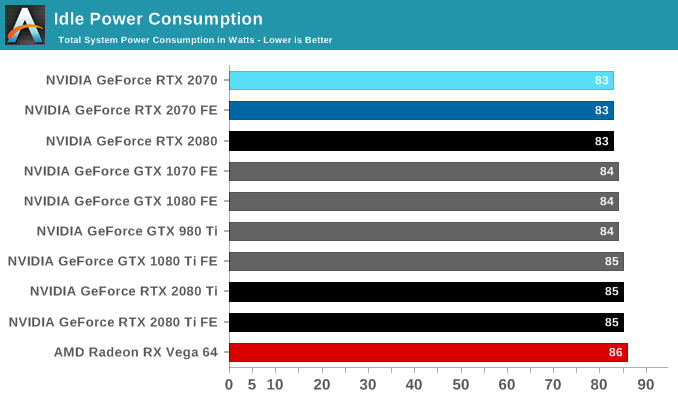
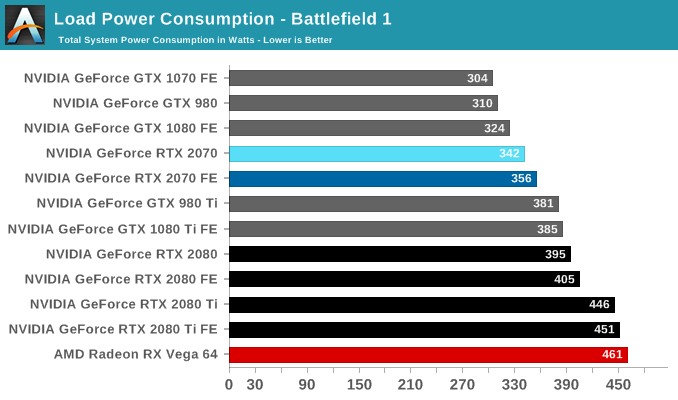
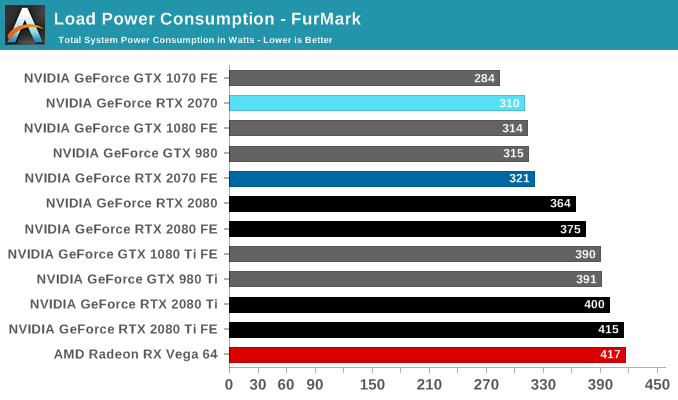
The steady TDP creep has taken its toll, and the 2070 is no longer a power-sipper of the likes of the 1070 or 970. At the very least, it is far from the excesses of its older 2080 Ti and 2080 siblings. Of note is its additional power draw over the GTX 1080, which in certain games trades blows with the 2070.
Temperature
The adoption of an open air cooler with dual axial fans has immediate benefits, especially with a lower temperature target.
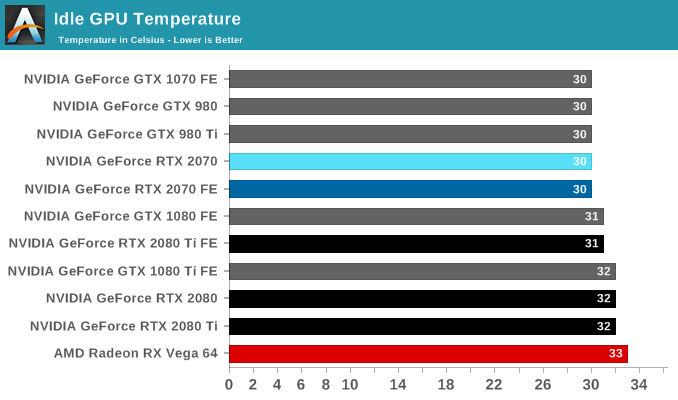
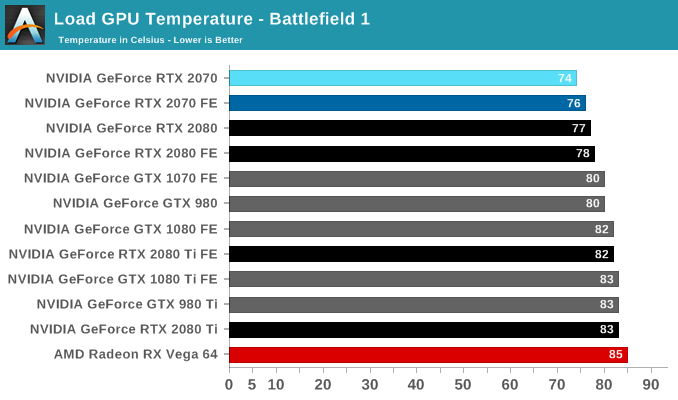
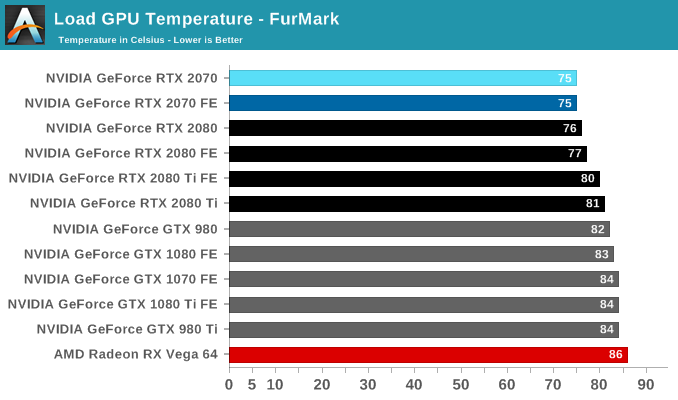
Noise
In turn, the open air cooler allows for quieter, slower spinning axial fans.

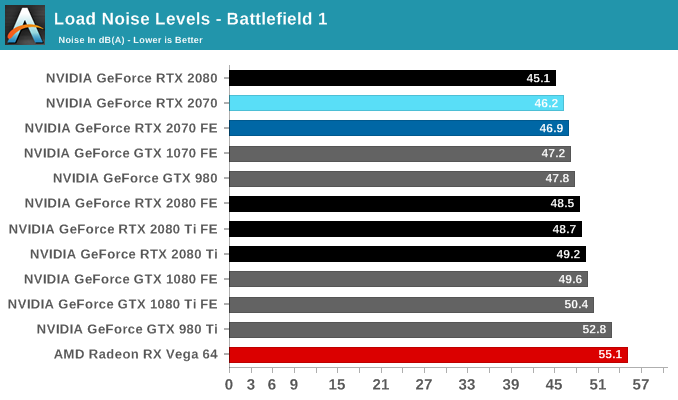
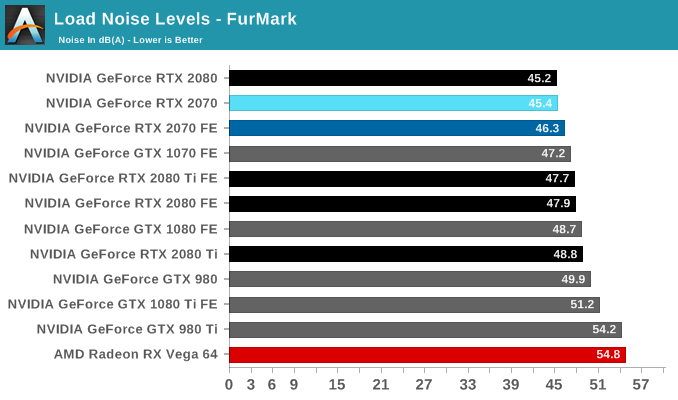










121 Comments
View All Comments
hansmuff - Tuesday, October 16, 2018 - link
Great review making some very pointed and smart commentary. Thank you!Hixbot - Tuesday, October 16, 2018 - link
Nvidia are not even interested in competing with themselves.shabby - Tuesday, October 16, 2018 - link
It's hilarious in a way, take the tensor cores and ray tracing out of the equation and there's barely any difference between pascal and Turing. It's almost like that extra memory bandwidth is giving Turing its speed bump and nothing more.PeachNCream - Tuesday, October 16, 2018 - link
NVIDIA is heavily marketing ray tracing as the killer feature for the RTX cards. Its clear that a generational gain in performance wasn't in the cards (pun intended) this time around.shabby - Tuesday, October 16, 2018 - link
And with Ray tracing turned on these things will perform like cards from 4 years ago. Nvidias going back to the future.AshlayW - Tuesday, October 16, 2018 - link
So in Far Cry 5, a game that I play a lot, I've essentially got RTX 2070 performance with my Vega 56 (OC+ Flashed to 64), but for £399 and the game free with it? Cool!The_Assimilator - Tuesday, October 16, 2018 - link
But you also need a small nuclear reactor to power it and a moderately-sized dam to cool it, so there's that.Spunjji - Wednesday, October 17, 2018 - link
If you run your computer for anything like sensible periods of time, that extra power draw still doesn't come close to amounting to the price difference. Remember, you have to consider it in context of the power draw of your entire home.pixelstuff - Tuesday, October 16, 2018 - link
I think my price limit on GPUs is the "not much more than an entire gaming console with slightly better performance" bracket of $350-400. I guess we'll see if the 2060 fits that bill and makes a worthy upgrade to the 970. Otherwise I'll be waiting one extra generation this time around instead of upgrading every other generation.Icehawk - Tuesday, October 16, 2018 - link
I’m with the crowd that says wtf to the new pricing - I’m a 670>970 owner and was hoping to upgrade to another x70 for $350-400 but they are priced too high for me now to justify. Hope they bring prices back to reality for the 2170 or that they offer GTX models along with RTX.If they want to shift the cards up a rank, IMO, they should have adjusted the naming schema.